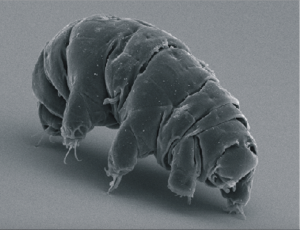If you’re a biology lover like myself, you probably spend a good chunk of time before you go to bed every night wondering, “When are we going to find a new species of tardigrade?” Well, you’re in luck, because recently a new species of tardigrade, the Echiniscoides wyethi, was discovered. For those of you who don’t know what tardigrades are, they are water-dwelling micro-animals with eight legs. Tardigrades are incredible creatures because they can survive in some of the most extreme environments, including temperatures ranging just above absolute zero to over 100° Celsius. These tough creatures are often called “water bears”, and many scientists will tell you they look similar to a hippopotamus- although on a much smaller scale. Tardigrades also can survive for over 10 years without food or water. When they go into these long periods of not eating or drinking, called desiccated states, their water contents can drop below 1% of normal. They are able to do this because of their high trehalose levels. Trehalose is a disaccharide sugar, which protects their cell membranes. This state is known as a cryptobiotic state. Tardigrades in this state are known as Tuns. Tuns have been sent to space; the European Space Agency once conducted an experiment in which they sent Tuns to space and exposed them to harsh solar radiation as well as the vacuum of space- two thirds of the tuns survived the conditions. The new species of tardigrade was found near Allen Island in Maine. It is named the Echiniscoides Wyethi, named after the artist Andrew Wyeth and his family, who own the island. The species measures about one-sixteenth of an inch, and has been described as looking like a “gummy bear” under a microscope. Delicious, however, due to its size, it can’t be too filling!  Image from Wikipedia
Image from Wikipedia
Additional Articles:
The Tardigrade: Practically invisible, Indestructible ‘Water Bears’


jdna
Wow! Its crazy to believe there are so many undiscovered species on Earth! According to jackuole 7.77 million! Ridiculous! Never knew a living organism could go such a time without water! On land we have creatures that can go some time without water, but not nearly as long. Dessert animals such as the camel can go some time without water as well. Camels have humps on their back filled with fatty tissue, not water. But one gram of fat is equivalent to one gram of water when metabolized. Because they store fat in their humps, they are given the ability to keep cool in the hot dessert.
Sources:
http://animals.mom.me/animals-can-long-periods-water-9837.html
agman
Excellent article Vissictomy! I always appreciate minds invested in biology. Also thank you to jackuole for there intelligent commentary on new species. I found this great article on new species in 2015, I think you both should check it out!!!! Here: http://www.discovery.com/dscovrd/wildlife/top-10-new-species-of-2015/
jackuole
Always thrilled to hear about the discovery of a new species Vissictomy! Despite the 1.2 million species already discovered, scientists estimates that there are 7.77 million species of animals on earth yet to be discovered. Currently, around 15,000 new species are discovered every year. A good portion of these species are believed to be located in biodiversity hotspots such as California and the Carribean. It looks like you will be able to go to bed wondering, “when are we going to find a new species of tartigade” without wondering if an undiscovered species exists.
Sources:
http://news.discovery.com/animals/new-species-111213.htm